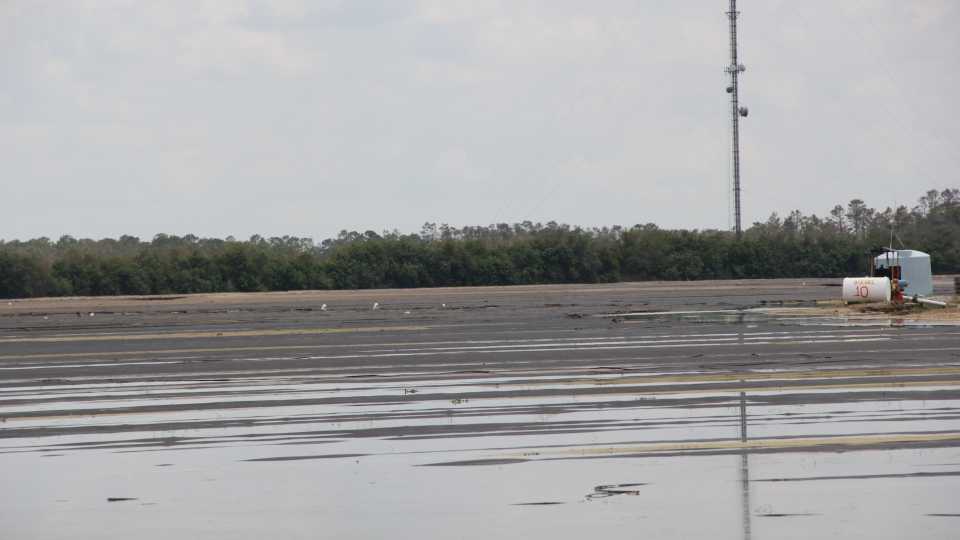Ways Florida Growers Can Keep Ahead of Pests Post-Irma

Many beds had to be pulled up and rebuilt in the aftermath of Hurricane Irma. Photo by Monica Ozores-Hampton
Hurricane Irma uprooted a lot of plans for growers as she moved her way across some of the state’s prime fruit and vegetable lands. While vegetable growers were fortunate that a great deal hadn’t been planted when the storm passed, it did destroy much of the field prep and beds built in preparation for the coming season.
Growers were sent scrambling to re-bed and plant trying to catch the market window for their winter crops. That meant some had to forgo fumigation of beds because there was no time to wait for the fumigation pre-plant requirements.
Strict fumigation restrictions require growers to wait — in some cases — up to a month before being able to plant. For growers who have already lost precious time and money due to Irma, rolling the dice without certain crop protection was the only way forward for this season. “They can’t do everything exactly how they’d like, and I am concerned there will be some problems for them down the road,” says Calvin Arnold, UF/IFAS Director of the Southwest Florida Research and Education Center. “They know that. They are very experienced and know they are playing Russian roulette. But they can’t sit around for three weeks waiting.”
Weed Watch
According to Ramadas Kanissery, an Associate Professor of weed science for UF/IFAS, says knowing a field’s history is particularly important after events like Hurricane Irma. He says there are two essential factors impacting weed pressure after a hurricane, whether fumigation was applied or not.
No. 1 is the weed profile of the field and what species of weeds have been historically found in the field. No. 2 is field topography.
“All vegetable fields are not the same with respect to what species of weeds are found in them,” Kanissery says. “Depending on whether the fields have grasses or broadleaf weed species, as well as the particular species involved, make a huge difference in potential crop profitability. Generally, grasses may consume more nutrients than broadleaf species, while the tall, broadleaf species interfere with pesticide operations.”
Field irrigation methods also will play an important role. Fields using seepage irrigation may encounter more weed pressure than fields on drip. Regardless of all factors, Kanissery says fields without fumigation will have greater weed pressure as a whole.
The importance of field scouting grows where fumigant applications were skipped. Kanissery says growers should be on the lookout for new weed species that might have been moved into the field by the storm and floodwaters.
“Check fields regularly to monitor new weed development, and make a field map of these weed locations and use the information toward planning next year’s weed control program,” he says. “Careful attention to row middles is necessary as well since fertilizer leaching from the beds has probably occurred as a result of heavy rains associated with the storms.”
When laying beds, Kanissery says there are some herbicides labeled to be applied on top of beds, which can provide some protection.
“To control yellow/purple nutsedge, annual broadleaves, and grasses, herbicides such as S-metolachlor (Brawl, Tenkoz; Dual Magnum and Medal, Syngenta), and Fomesafen (Reflex, Syngenta) may be used on bed tops, pre-transplant, just before laying the plastic,” he says. “Also, when doing a pre-emergent spray or post-transplant application of herbicide(s) onto the beds some efforts may be needed to prevent crop injury. For instance, adjusting sprayer nozzle placement, using sprayer guards, etc. are some approaches to prevent direct spraying into the plant holes or onto the transplanted plants.”
Finally, Kanissery suggests growers consider a bioassy test of soil where crops are being planted into after flooding because it can move residues from previous herbicide applications.
“Herbicide bioassay is a technique used to identify if the herbicide is present in soils at concentrations high enough to inhibit germination and affect crop growth.”

Floodwaters can displace previously applied herbicides, making a bioassay test a wise move in rebuilt plastic beds to avoid crop injury. Photo by Monica Ozores-Hampton
Disease Duty
According to Dr. Pam Roberts, a Professor of plant pathology with UF/IFAS, when it comes to diseases post-Irma, the importance of field scouting is enhanced to quickly diagnose disease outbreaks.
“If the history of the field is known, then growers could probably expect to see the same soilborne disease(s) manifest,” she says. “The environment also will have an influence. For example, with the rain and cooler temperatures, we might see an increase in diseases favored by these conditions. The important thing is for growers to continue with their IPM programs, maintain scouting, and get assistance with disease identification if needed in order for fungicides to be targeted to those diseases present.”










